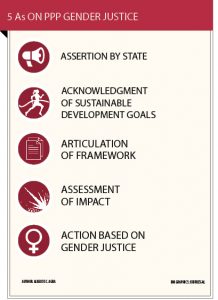‘Responsive-ility’ and responsibility Public-Private Partnership (PPP) arrangements—whether for water, reclamation, power, mass transport systems and…
5 As: No PPP justice without gender justice
5 As: No PPP justice without gender justice
 Why is promoting women and girls’ rights important in achieving the purpose of public-private partnerships (PPPs)? How can PPPs improve the quality of life of women and girls? How do we dovetail PPP justice with gender justice?
Why is promoting women and girls’ rights important in achieving the purpose of public-private partnerships (PPPs)? How can PPPs improve the quality of life of women and girls? How do we dovetail PPP justice with gender justice?
According to the Development Alternatives with Women for a New Era, in an article PPP and Gender Justice in the context of the 3rd UN Conference of Financing for Development, there is evidence which shows that “existing PPPs in the field of health do not contribute to alleviating fiscal pressure, and frequently fail to deliver health care and services needed by women, especially women living in poverty.”
We hope that if and when the national government enters into and implements a PPP project on health, said “failure” would not happen. In the Philippines the first PPP project on health—the modernization of the Philippine Orthopedic Center—was awarded, but will not push through. The private sector walked away due to unmet obligations of the government.
To avoid such a situation in any and all PPP projects, the following prescriptions—the 5 As—are being offered:
(1) Assertion by the State. The State, in any PPP arrangement, must not abdicate its duty to protect and promote the interests of women and girls. Regardless of the modality, the State must define the agenda, set the policy and regulate.
(2) Acknowledgment of Sustainable Development Goals (SDGs). The 5th SDG states that all nations must “achieve gender equality and empower all women and girls” through the provision of public services, infrastructure and social protection policies, ensuring women’s full and effective participation and equal opportunities for leadership at all levels of decision-making in political, economic and public life, and undertaking reforms to give women equal rights to economic resources.
To achieve this SDG, and the other SDGs, partnerships are needed. The 17th SDG calls on us to “encourage and promote effective public, public-private and civil-society partnerships, building on the experience and resourcing strategies of partnerships.”
(3) Articulation of framework. Said SDG must be embodied in a framework, either law or rule. The inclusion of provisions on “gender justice” should also be incorporated in PPP contracts. The formulation of the framework must be inclusive and participative. Women and girls have a stake in PPPs.
(4) Assessment of impact. According to the article cited above, the “impact of PPPs on women’s human rights, as well as the way they respond to women’s diverse needs should be specifically considered at all stages: design, implementation, monitoring and assessment.” Specific gender-based key performance indicators must be spelled out in the contract and must be part of the deliverables of the PPP parties.
(5) Action based on gender justice. The welfare of women and girls must be improved, their equal access enhanced and their participation guaranteed. Aside from streamlining and integrating women and girls’ rights in PPP policies and projects, gender-responsive PPP projects must also be identified, prioritized and implemented.
The 5 As must go beyond lip service. There can be no justice through PPPs without gender justice.
